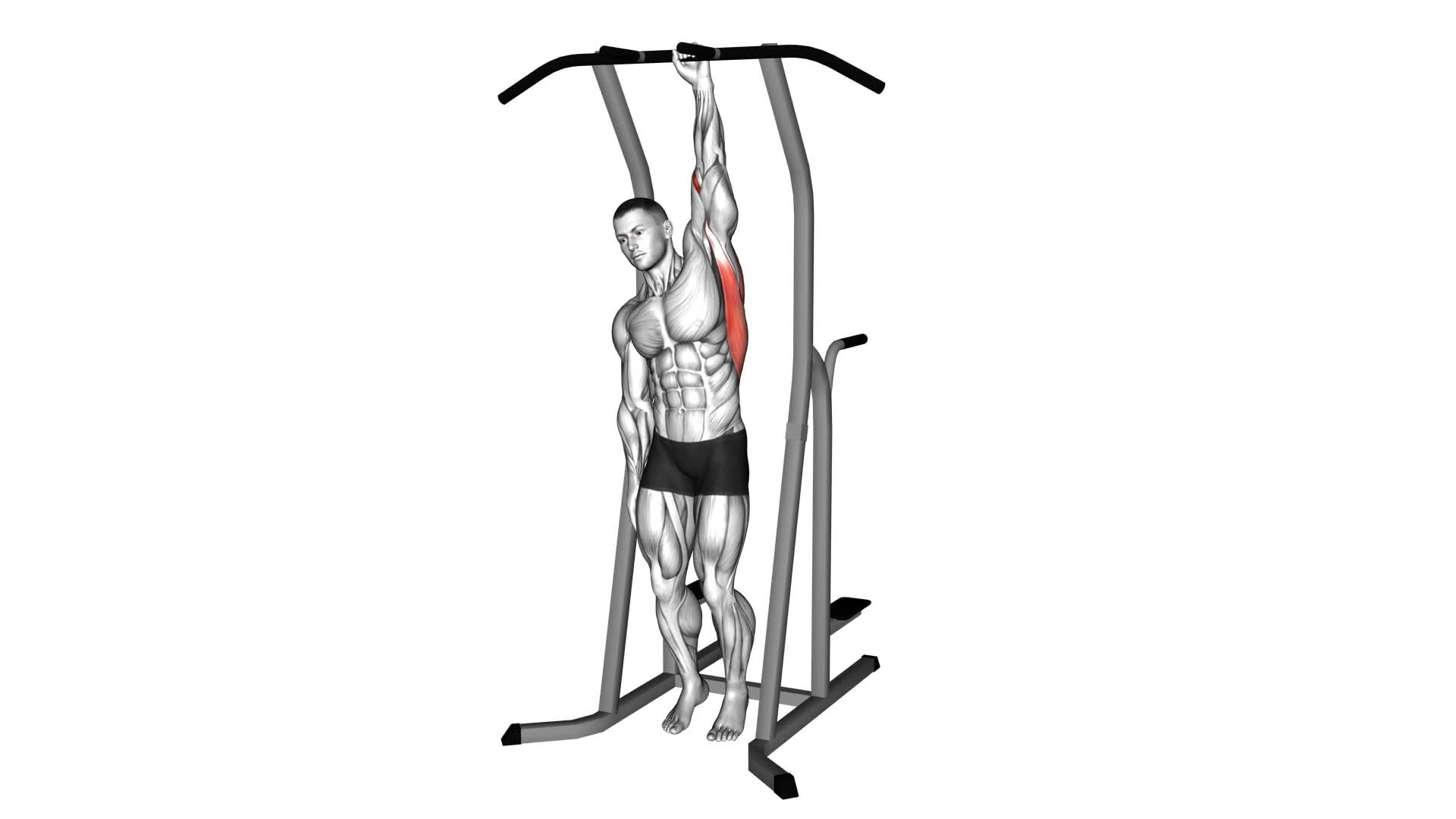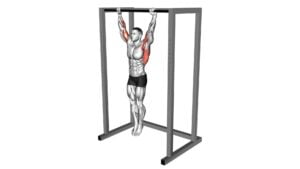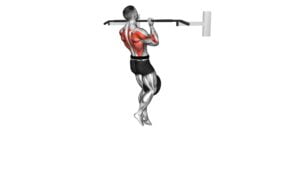One Handed Hang Stretch – Video Exercise Guide & Tips

Are you looking for a way to improve your flexibility and strength?
Watch This Exercise Video
Check out our One Handed Hang Stretch video exercise guide! In this guide, we'll show you the proper form and technique for performing this stretch, as well as common mistakes to avoid.
We'll also provide modifications and progressions to challenge yourself as you become more advanced.
Maximize the effectiveness of your stretches with our helpful tips.
Get ready to take your flexibility to the next level!
Key Takeaways
- The one-handed hang stretch improves strength, flexibility, and targets different muscle groups.
- Proper form and technique, as well as warm-up and safety precautions, are crucial for performing the stretch safely.
- Modifications and progressions, such as alternative grip options and increased resistance levels, can enhance the effectiveness of the exercise.
- Gradual progression and patience are important for maximizing effectiveness and reducing the risk of injuries.
Benefits of the One Handed Hang Stretch
By regularly incorporating the one-handed hang stretch into your workout routine, you can experience numerous benefits that will improve your strength and flexibility. The one-handed hang stretch variations are designed to target different muscle groups and challenge your body in unique ways. These variations include using a towel or resistance band for added resistance, or performing the stretch with one arm while engaging the core for stability.
One of the advanced one-handed hang stretch techniques is the one-handed hang with rotation. This exercise not only stretches your shoulders and upper back, but also engages your core and improves your rotational mobility. Another technique is the one-handed hang with knee tuck, which targets your abdominals and hip flexors while also stretching your shoulders.
Incorporating these variations and techniques into your workout routine won't only enhance your strength and flexibility, but also increase your body awareness and control. You'll develop a stronger grip, improved shoulder stability, and greater overall body strength. These benefits can translate into improved performance in other exercises and activities.
Now that you understand the benefits of the one-handed hang stretch, let's move on to the next section where we'll discuss proper form and technique for performing this stretch.
Proper Form and Technique for the One Handed Hang Stretch
To perform the One Handed Hang Stretch with proper form and technique, it's crucial to focus on hand placement and grip.
Ensure that your hand is firmly gripping the bar and your fingers are spread wide for maximum stability and control.
Additionally, be mindful of the benefits and precautions associated with this exercise to prevent any potential injuries and optimize your results.
Hand Placement and Grip
Place your hand securely on the bar and grip it firmly to maintain proper form and technique for the One Handed Hang Stretch. Here are some key points to remember about hand placement and grip:
- Hand positioning for optimal grip strength: Make sure your hand is fully wrapped around the bar, with your fingers and thumb securely gripping it. This will help you maintain a strong grip throughout the exercise.
- Variations of grip for targeting different muscle groups: Experiment with different grip variations to target specific muscles. For example, an overhand grip primarily works your back and shoulders, while an underhand grip targets your biceps and forearms. You can also try a neutral grip, where your palms face each other, to engage your chest and triceps.
- Avoid excessive squeezing: While it's important to grip the bar firmly, be mindful of not squeezing too tightly. This can cause unnecessary tension in your hand and forearm muscles, leading to fatigue and discomfort.
- Regularly switch hands: To ensure balanced muscle development, make sure to perform the One Handed Hang Stretch with both hands. Alternate between left and right hands to evenly distribute the workload and prevent muscle imbalances.
Benefits and Precautions
When performing the One Handed Hang Stretch, it's important to be aware of the benefits and precautions to ensure proper form and technique.
This exercise primarily targets the muscles in your forearm, helping to improve grip strength and forearm flexibility. Additionally, it can also enhance wrist stability and promote better overall upper body strength.
However, it's crucial to approach this exercise with caution, as there are potential risks involved. The most common risk is overstraining the muscles and tendons in your forearm, which can lead to injury. To minimize these risks, it's essential to start with a lighter weight and gradually increase as you build strength and flexibility.
Remember, proper form and technique are key to reaping the benefits while minimizing the risks associated with the One Handed Hang Stretch.
Moving forward, let's discuss common mistakes to avoid during this exercise.
Common Mistakes to Avoid During the One Handed Hang Stretch
Avoiding common mistakes is crucial when performing the One Handed Hang Stretch exercise. To ensure you're getting the most out of this stretch while also staying safe, it's important to be aware of the following common mistakes and take appropriate safety precautions:
- Not using proper form: When performing the One Handed Hang Stretch, it's important to maintain proper form throughout the exercise. Avoid arching your back or rounding your shoulders, as this can lead to strain or injury.
- Overstretching: While it's important to stretch and challenge your muscles, overstretching can lead to injury. Avoid pushing yourself too far and listen to your body's limits.
- Neglecting warm-up: Before attempting the One Handed Hang Stretch, make sure to warm up your muscles to reduce the risk of injury. Perform a few dynamic stretches or light exercises to increase blood flow and prepare your body for the stretch.
- Not using proper equipment: Ensure that you have a sturdy and secure bar or surface to hang from. Using unstable or weak equipment can increase the risk of accidents or falls.
By being mindful of these common mistakes and taking the necessary safety precautions, you can maximize the benefits of the One Handed Hang Stretch while minimizing the risk of injury.
Now, let's move on to discussing modifications and progressions for this exercise.
Modifications and Progressions for the One Handed Hang Stretch
To make the One Handed Hang Stretch more challenging or adaptable to your needs, there are a few modifications and progressions you can try.
One option is to experiment with alternative grip options, such as using a towel or lifting straps to assist with the exercise.
Another way to progress is by increasing the resistance levels, either by adding weight or using a resistance band.
These modifications and progressions can help you continue to challenge your muscles and improve your flexibility over time.
Alternative Grip Options
Try different grip options to modify and progress your one-handed hang stretch.
Grip strength and finger placement are crucial for a successful and effective one-handed hang stretch. Here are four alternative grip options to consider:
- Closed Fist Grip: Make a fist with your hand and wrap your thumb around your fingers. This grip helps to strengthen your grip and develop finger strength.
- Finger Tip Grip: Place your fingertips on the edge of the bar, with your fingers slightly bent. This grip targets your finger strength and improves your grip endurance.
- Towel Grip: Wrap a small towel around the bar and grip the ends of the towel with your hand. This grip challenges your grip strength and forearm muscles.
- Mixed Grip: Hold the bar with one hand using an overhand grip and the other hand using an underhand grip. This grip variation helps to develop grip strength and forearm muscles asymmetrically.
Experiment with these different grip options to find the one that works best for you and helps you progress in your one-handed hang stretch. Remember to always listen to your body and adjust the intensity accordingly.
Increasing Resistance Levels
To increase the resistance levels in the one-handed hang stretch, you can incorporate weighted gloves or wrist weights. These additional weights will challenge your muscles and help you achieve more significant gains in strength and flexibility.
Start by selecting a weight that's comfortable yet challenging for you. Gradually increase the weight as you become stronger and more accustomed to the exercise.
Another option is to try advanced variations of the one-handed hang stretch, such as using a towel or resistance band. These variations add an extra level of difficulty and resistance to your workout.
Remember to always listen to your body and progress at a pace that's appropriate for you.
Tips for Maximizing the Effectiveness of the One Handed Hang Stretch
To maximize the effectiveness of the One Handed Hang Stretch, ensure that you maintain a strong grip throughout the entire exercise. By doing so, you won't only target the desired muscles but also increase the benefits of this stretch. Here are some tips to help you make the most out of your One Handed Hang Stretch:
- Engage your core: By activating your core muscles, you stabilize your body and enhance the stretch. This will maximize flexibility and improve overall balance.
- Relax your shoulders: It's important to keep your shoulders relaxed during the stretch. Tension in the shoulders can hinder the effectiveness of the exercise and increase the risk of injury.
- Maintain proper form: Make sure your body is aligned in a straight line from your head to your heels. This correct posture will allow for a deeper stretch and prevent strain on your joints.
- Gradually increase the duration: Start with shorter durations and gradually increase the time you spend in the One Handed Hang Stretch. This progressive approach will help you build strength and flexibility safely.
Safety Precautions and Considerations for the One Handed Hang Stretch
Before attempting the One Handed Hang Stretch, it's important to consider safety precautions and take certain factors into account. Injury prevention should be a top priority when engaging in any exercise routine, and the One Handed Hang Stretch is no exception.
To minimize the risk of injury, it's crucial to warm up properly before attempting this stretch. Warm up exercises help increase blood flow to the muscles, making them more flexible and less prone to strains or tears. Incorporate dynamic stretches such as arm circles, shoulder rolls, and wrist rotations to prepare your upper body for the One Handed Hang Stretch.
When performing the One Handed Hang Stretch, maintain proper form and technique to prevent injuries. Ensure that you have a secure and stable surface to hang from, such as a sturdy pull-up bar. Avoid overexertion and listen to your body's limits. If you experience any pain or discomfort, stop immediately and seek professional guidance.
Additionally, it's essential to progress gradually in your One Handed Hang Stretch routine. Start with shorter durations and gradually increase the time as your strength and flexibility improve. Pushing yourself too hard too soon can lead to injuries, so be patient and allow your body to adapt to the demands of the stretch.
Frequently Asked Questions
How Long Should I Hold the One-Handed Hang Stretch For?
To get the most out of the one-handed hang stretch, it's important to know how long to hold it. Holding the stretch for about 30 seconds to a minute is a good starting point. This allows your muscles to fully relax and lengthen.
The one-handed hang stretch offers many benefits, such as improving grip strength and increasing flexibility in your arms and shoulders.
Remember to listen to your body and adjust the duration of the stretch as needed.
Can I Do the One-Handed Hang Stretch if I Have a Shoulder Injury?
If you have a shoulder injury, it's important to prioritize your rehabilitation exercises.
The one-handed hang stretch may not be suitable for you at this time.
However, you can modify the exercise by using a lighter weight or performing it with your uninjured arm.
It's crucial to consult with a healthcare professional or physical therapist to determine the best course of action for your specific injury and recovery process.
What Are Some Alternatives to the One-Handed Hang Stretch for People With Limited Grip Strength?
If you have limited grip strength, there are alternatives to the one-handed hang stretch that can still help you strengthen your hands and arms.
Try incorporating strength training exercises that focus on your forearm muscles, such as wrist curls and reverse curls.
Additionally, hand grip strengthening exercises like squeezing a stress ball or using hand grippers can be beneficial.
These alternatives can help improve your grip strength without putting too much strain on your shoulders.
Can I Use a Resistance Band to Assist With the One-Handed Hang Stretch?
Yes, you can definitely use a resistance band to assist with the one-handed hang stretch. It can be a great option for people with limited grip strength or those who are working towards building up their strength.
When using a resistance band, make sure to maintain proper form and technique by keeping your shoulder down and engaging your core. This will help you get the most out of the exercise and avoid any unnecessary strain or injury.
Is It Better to Do the One-Handed Hang Stretch Before or After a Workout?
It's important to consider the benefits of doing the one-handed hang stretch before or after your workout.
Pre-workout, this stretch can help improve your grip strength and activate the muscles in your arms and shoulders, preparing them for exercise.
Post-workout, it can aid in recovery by stretching and lengthening the muscles you just worked.
Conclusion
In conclusion, the one-handed hang stretch is a beneficial exercise for improving flexibility and strength in the upper body.
By properly performing the exercise with correct form and technique, individuals can target their shoulders, arms, and back muscles effectively.
Avoiding common mistakes and making necessary modifications can help progress in the exercise and maximize its effectiveness.
However, it's important to prioritize safety and consider any individual limitations or precautions before attempting the one-handed hang stretch.

Author
Years ago, the spark of my life’s passion ignited in my mind the moment I stepped into the local gym for the first time. The inaugural bead of perspiration, the initial endeavor, the very first surge of endorphins, and a sense of pride that washed over me post-workout marked the beginning of my deep-seated interest in strength sports, fitness, and sports nutrition. This very curiosity blossomed rapidly into a profound fascination, propelling me to earn a Master’s degree in Physical Education from the Academy of Physical Education in Krakow, followed by a Sports Manager diploma from the Jagiellonian University. My journey of growth led me to gain more specialized qualifications, such as being a certified personal trainer with a focus on sports dietetics, a lifeguard, and an instructor for wellness and corrective gymnastics. Theoretical knowledge paired seamlessly with practical experience, reinforcing my belief that the transformation of individuals under my guidance was also a reflection of my personal growth. This belief holds true even today. Each day, I strive to push the boundaries and explore new realms. These realms gently elevate me to greater heights. The unique combination of passion for my field and the continuous quest for growth fuels my drive to break new ground.







